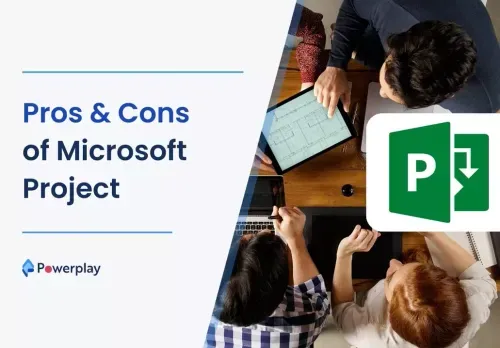Pros & Cons of Microsoft Project
-
Kumar Abhishek Anand
- October 12, 2023

Project Management is crucial for any business, especially for those which comprise a lot of variables and need to be consistently managed. Project management techniques are evolving with the onset of modern technologies and are being developed to match the pace at which the industry is growing.

A project management process includes planning & designing, scheduling tasks, coordinating, communicating, regular updating, and evaluation. Project management includes prioritizing processes according to their importance, setting milestones, and directing the respective parties to complete those tasks. Project management tools or software helps to manage project operations smoothly by assisting project managers and project teams to work more efficiently.
Table of Contents
ToggleWhat is Microsoft Project?

Microsoft Project(MSP) is one of the majorly used project management tools in the industry to manage almost all types of projects. It is a flexible project management and scheduling software that has been used commercially since the 1980s. Its robust project management features are quite effective and efficient. Initially, it was web-based which was later developed for desktops.
Microsoft Project uses the Azure Cloud as its computing platform and has a user base of more than 20 million professionals and over 10000 organizations – including big names such as Coca-Cola and AIMCO.

Microsoft Project empowers professionals to manage projects as per the project status or objectives. It offers a simple and innate user interface where users can seamlessly shift between grids, graphs, Gantt charts, etc to track progress and the integrated support from Microsoft Teams enhances coordination.
All the team members can co-author or edit information simultaneously and use the automated scheduling feature based upon tasks, duration, and supplies. Microsoft Project provides diverse options to create interactive dashboards in Power BI(Microsoft Project Platform) to visualize projects from different perspectives. Also, the RoadMap feature provides a magnified and enhanced picture of the project operations in sequence.

Microsoft Project offers three different subscription packages, Project Plan 1, Project Plan 2, and Project Plan3, more commonly known as Project For the Web, Project Online, and Project Online Desktop Client respectively. These can be briefly explained as:
- Project Management- Project managers can keep an eye on the task schedule via different data presentation techniques such as bar charts, Gantt charts, grid view, etc. Coordination among all stakeholders is also facilitated by providing features such as editing and updating of item lists, schedules, hierarchies, etc. Timesheet submission is one of the unique features of Microsoft Project that allows tracking of project and non-project times for invoicing.

- Portfolio Management- Microsoft Project has provisions to manage multiple projects and programs of an organization simultaneously and set priority to these projects. Advanced features such as business intelligence allow modeling of different scenarios that are possible to assist organizations to choose the best course of action along with higher profit ratios, and also evaluate and compare proposals at hand against objectives and requirements.
- Resource Management- Microsoft Project helps in the early prediction of resource requirements, hold-ups, resource utilization, etc to ensure timely project completion. The resources can be requested as per demand, and tasks can be assigned as per the resources using Microsoft Project along with resource utilization tracking across the project. The progress on resources, projects, programs, and portfolios can also be tracked using Microsoft Project.
Advantages
There are a lot of features that make the Microsoft Project tool advantageous and some of them have been explained below:
01 – Planning and Scheduling– Microsoft Project helps users to prioritize tasks, schedule them, define the various steps involved in them, and finally assign them to the respective teams or members. It assists in timeline visualization as it can link dependant tasks or create sub-tasks and can set criteria for tracking progress.
Teams have full visibility of the ongoing tasks and projects status from the shared team calendar which allows users to sync work schedules and send meeting notifications. This is crucial for any organization that handles multiple projects simultaneously.
02 – Integration– Microsoft Project is compatible with other software such as Microsoft 365, Microsoft Team, Skype, Sharepoint, etc. It is also easily integrated with Microsoft Azure and other Microsoft software.
03 – Flexibility– Microsoft Project is quite flexible due to certain features such as the road mapping tool and financial management. Users or teams get more choices to configure the project according to any changes or user requirements. The software tracks resource availability and assigns costs accordingly to monitor and evaluate how the priceless resources are being used.
04 – Structured Reporting– Microsoft Projects allows users to customize their report formats to include all project status aspects and meet the user’s requirements. These reports can include cost spendings, resources in stock, tasks accomplished, and even an entire project overview. Along with providing essential insights into project operations, these projects assist in computing employees’ work hours to provide their salaries accordingly and to ensure that they complete the work on time.
05 – Remote Working– Users or teams can review, update and work on projects or tasks simultaneously from anywhere in the world. Not only can they work from anywhere in the world but also on multiple devices to increase productivity.
06 – Secure Platform– Organizations that deal with a huge amount of sensitive data and investment need secure tools to protect their information sets. Since the data on Microsoft Project is integrated with Azure which has been built as one of the most expensive and advanced threat intelligence systems that ensure the security of data.
07 – Interactive Dashboards– Microsoft Project offers a variety of interactive dashboards that can be configured data in a variety of visualization formats to provide better insights into a project’s process. The dashboard feature has attractive features such as customized graphs and charts that keep the operations, tasks, and progress of the project streamlined and comprehensive.
Disadvantages
Although Microsoft Project is a top-class, powerful, flexible, and great team-up tool, it has its own set of disadvantages. Some of these disadvantages include :
01 – Intensive Training for Beginners– The learning curve for Microsoft Project is not a simple straight line curve for anyone who is not familiar with the software and can be overwhelming to new users. Project managers have often complained about the large time requirement that is needed for freshers to learn and navigate Microsoft Project.
02 – Expensive Subscriptions– Many users have complained about the expensive subscriptions for the software or some of its features. Some even feel that the price charged as per functionality/feature is very high and the cloud-based versions are not the same as on-premise versions. Due to this many users who purchase only some features of Microsoft Project lack productivity. It is certainly not a viable option for small businesses.
03 – Compatibility Issues– Microsoft Project files cannot be opened on any other platform due to Microsoft’s proprietary file format for the software. Even the free applications that can open Microsoft Project files can only open it in read-only format. Some features with which the file has been prepared are also missing sometimes when opened from different read-only software.
Share
Kumar is a digital content professional with more than 2 years of experience in Blog writing, copywriting and scripting. His passion lies in the art of creating convincing content that plays a major role in converting leads for SAAS businesses.












